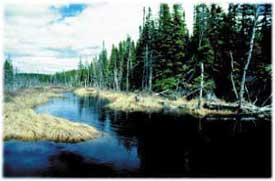Building Blocks

The history of science at Stroud Water Research Center is the story of scientists who have built on prior work, one experiment at a time. The study of dissolved organic matter (DOM), which began with the Rockefeller grant and most recently flowered in the concept of watershed tea, provides a case in point.
The timeline begins in the late 1960s, when Robin Vannote was putting leaf packs in White Clay Creek, Tom Bott was studying the microbial decomposition of those leaves and measuring the impact of algae on stream life, and Rick Larson was providing one of the first in-depth looks at the organic chemistry of stream water.
These varied activities were all part of an effort to understand the role terrestrial and instream sources of food play in stream ecosystems. And they led, in the early 1970s, to one of the River Continuum Concept’s main hypotheses — that the diversity of DOM compounds was at its maximum in a small headwater stream and diminished rapidly as the stream grew into a large river.
The Center, however, did not have the instrumentation necessary to test the hypothesis. In the mid-1970s, Lou Kaplan secured a National Science Foundation grant to buy a DOM analyzer, which enabled him to investigate the sources and uses of DOM in the White Clay watershed.
By the end of the decade, Kaplan and Tom Bott had focused their joint studies on how DOM is used and degraded in a stream and how bacteria can actually acclimate themselves to the specific nature of a watershed’s food supply. A few years later the scientists moved on to study how the DOM-fed bacteria interact with algae and protozoa to help form the basis of the stream’s food web.

After reading Kaplan and Bott’s published results, scientists at the Environmental Protection Agency funded them to look at the growth of bacteria in drinking water and at the impact of organisms which had been genetically engineered to degrade DOM compounds.
Bott’s research expanded to more thorough investigations of the microbial food web, including working to determine what happens to toxic substances that enter the food web. Meanwhile, Kaplan developed a bioreactor that measures how efficiently bacteria consume DOM. Using his instrument, a water utility can determine the most effective treatment process, measure the results and monitor the quality of the treated drinking water.
On Feb. 23, 1999, Kaplan was awarded a patent for his reactor and for the method he developed to measure contaminants in drinking water.
The next step in the research was to measure the influence of DOM chemistry on the composition of bacterial communities. As part of that effort, new tools in molecular microbial ecology, such as DNA analysis, will provide a first look at the numbers and kinds of bacterial species in streams, and new tools in analytical organic chemistry will supply the data to test the River Continuum hypothesis on the diversity of DOM in stream ecosystems.
Thus does ongoing research at the Center build on the scientific foundation of the past, provide answers to questions posed decades earlier and become the stage from which future projects will be launched.
Learn More About Our History
The Beginning | The Watershed | Landmark Research | Art and Science | Road to Independence | Building Blocks
Celebrate Stroud Water Research Center’s history — from its humble beginning in Joan and Dick Stroud’s garage to a world-renowned freshwater research institution — with our anniversary book, The First Fifty Years.
